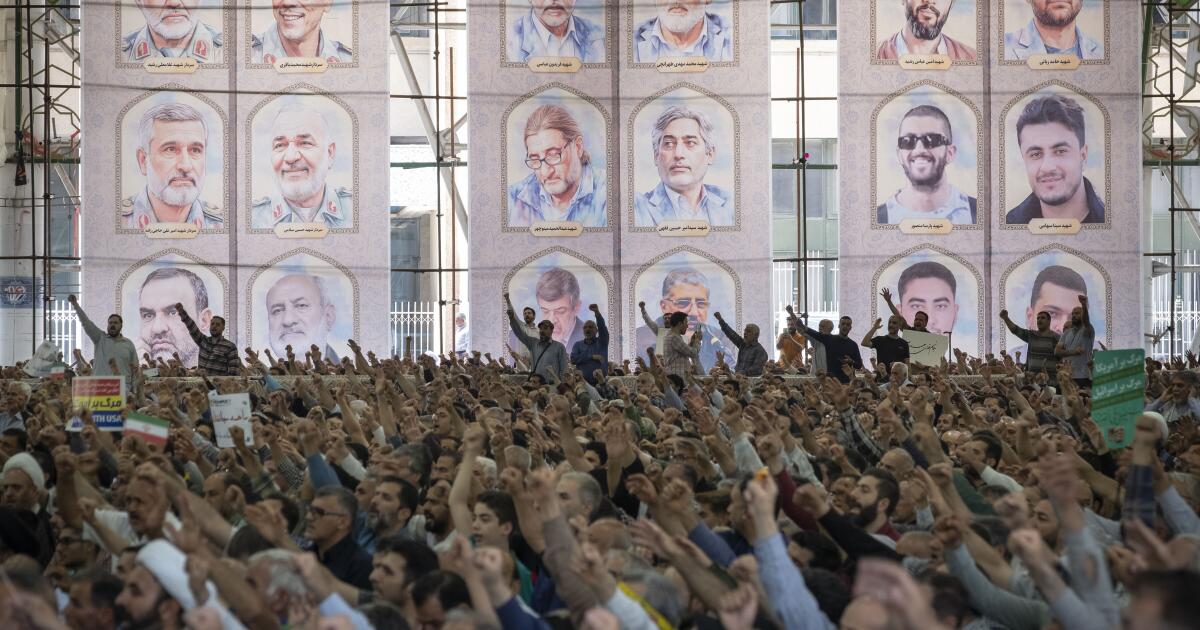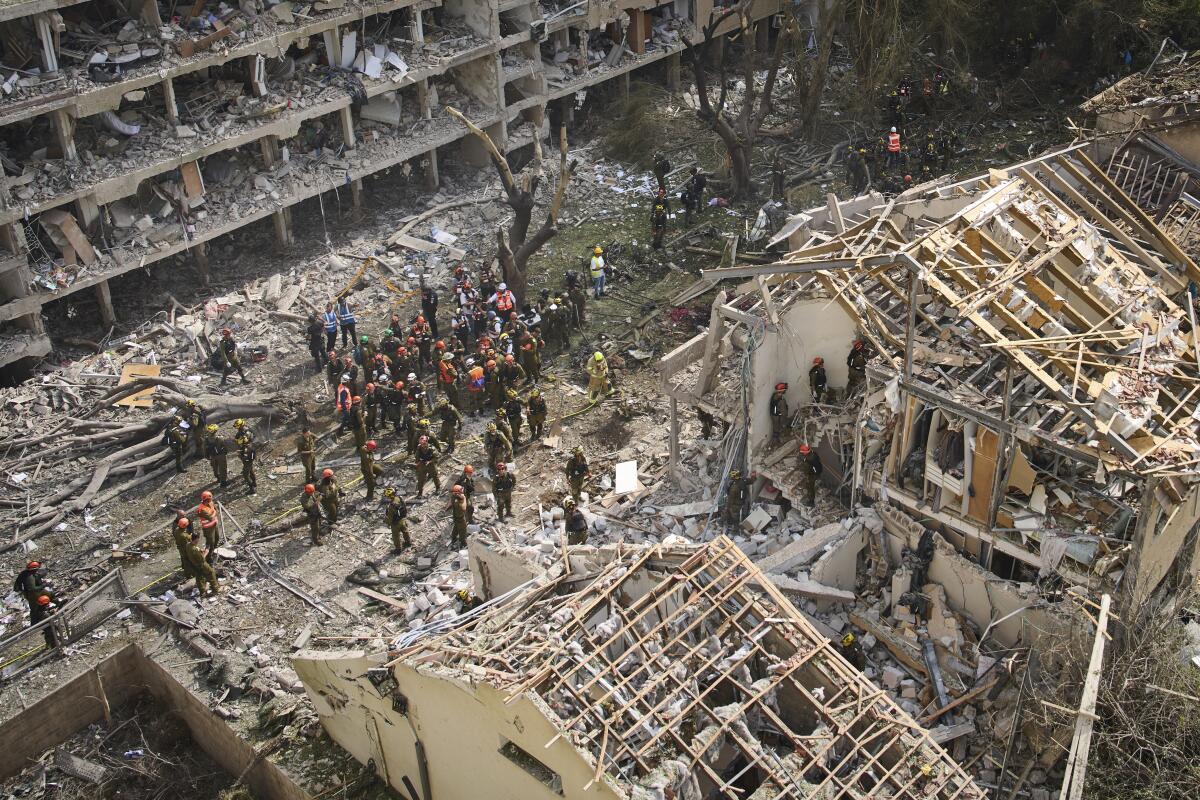News Analysis: Israel declared triumph, but Iran’s nuclear future still looms

BEIRUT — After a hastily cobbled together ceasefire between Israel and Iran took hold on June 24, Israeli Prime Minister Benjamin Netanyahu jubilantly declared that the “existential threats” of Iran’s nuclear program and ballistic missile arsenal had been destroyed. The “historic victory,” he said, would “abide for generations.”
But nearly two weeks after President Trump deployed 30,000-pound bombs and Tomahawk missiles against Iran’s nuclear facilities, questions linger over how abiding that victory will prove to be. Even as U.S. and Israeli intelligence services continue assessing the strikes, and the White House insists Tehran may acquiesce to a grand bargain for peace in the region, analysts say the hostilities were less a finale than a prelude to the next act.
“There will be a sequel. The war remains an unfinished project, for both sides,” said Bader Al-Saif, a professor of history at Kuwait University. Israel, he added, “wants to see the end of the Iranian regime or a more serious decapitation of its capabilities.”
For the Islamic Republic’s leaders, who have defied and antagonized Israel — and the U.S. — for decades, that they emerged bruised but not beaten serves as proof they should continue.
“Regardless of the superiority of Israeli and American firepower, they’re still there,” Al-Saif said. “And they’re there for the long run.”
Israel’s 12-day campaign is the first time the long-running shadow conflict between the Middle East’s military superpowers exploded into open warfare, decapitating the upper echelons of Iran’s military and nuclear leadership. Israel’s spy service conducted elaborate sabotage operations on Iranian soil. Wave after wave of airstrikes killed hundreds of people and turned vital installations, infrastructure and city neighborhoods into piles of rubble.

Smoke rises from a command center of the Islamic Revolutionary Guard Corps north of Tehran on June 23, after being targeted by Israel.
(ELYAS / Middle East Images )
From the moment Trump announced the B-2 Spirit bomber strikes, he and other members of his administration have repeated the word “obliterated” when describing their impact.
Though an initial damage analysis expressed skepticism, a consensus emerged that Iran’s enrichment and weaponization infrastructure, including centrifuges and uranium metalworking equipment, was destroyed or rendered inoperable. Iranian Foreign Minister Abbas Araghchi said in an interview Tuesday with CBS News that Iran’s Atomic Energy Organization was still evaluating the impact at the Fordo site, “but what we know so far is that the facilities have been seriously and heavily damaged.”
How enduring the setback will be to Iran’s nuclear ambitions is another matter.
Araghchi added that Iran’s “peaceful nuclear program has turned into a matter of national pride and glory” and that “people will not easily back down from enrichment.”
“One cannot obliterate the technology and science for enrichment through bombings,” Araghchi said. “If there is this will on our part, and the will exists in order to once again make progress in this industry, we will be able to expeditiously repair the damages and make up for the lost time.”
Iranian officials put the death toll of the war at 935 people, including 38 children and 132 women; they did not specify how many of the men were civilians.
The U.S., European powers and Iran signed a deal in 2015 conditioning sanctions relief on Iran restricting enrichment of uranium to 3.67% (enough for civilian use), giving up significant amounts of its uranium stockpile and allowing the International Atomic Energy Agency inspectors to monitor facilities.
Trump withdrew from the deal in 2018, saying it didn’t go far enough, and he imposed what he termed “maximum pressure” sanctions on Iran. He began his second term with efforts to negotiate a new agreement; Israel began its attack on Iran as talks were underway.
Experts believe Iran still has centrifuges it manufactured before the war but had never installed, as well as a stockpile of uranium enriched to 20% and 60%, sufficient for 10 warheads.
“Bottom line is that Iran has the foundational elements that it could use to reconstitute an enrichment effort,” said Eric Brewer, deputy vice president of the Nuclear Materials Security Program for Nuclear Threat Initiative, a Washington think tank.
Weaponizing that uranium is a murkier prospect, he added. Israel killed 14 veteran Iranian nuclear scientists, but the know-how is likely to have remained, Brewer said.
“Iran is clearly not willing to abandon its nuclear program,” he said. “It’s a question of what form that reconstituted program will take, and how long Iran needs to fulfill it.”

People fold tents at an underground shelter in Tel Aviv on June 24, 2025, after the ceasefire with Iran was announced.
(Ohad Zwigenberg / Associated Press)
Meanwhile, Tehran has already taken steps limiting inspectors’ access to its nuclear program. On Wednesday, Iranian President Masoud Pezeshkian signed into law a bill suspending cooperation with the IAEA, the United Nations’ nuclear watchdog, until guarantees are given for the security of nuclear facilities and scientists.
The 12-member Guardian Council, half of whom are appointed by Iranian Supreme Leader Ayatollah Ali Khamenei, approved it the next day.
Continuing with any enrichment is likely to be a nonstarter for Trump, who says he “without question” would bomb any Iranian rebuilding effort. The Israelis too have threatened to strike again should they perceive a threat.
But that calculus thrusts all sides into a perpetual game of cat-and-mouse, with Iran going to ever-greater lengths to conceal its activities while the U.S. and Israel keep watching for Tehran’s maneuverings.
Israel has employed a similar playbook in Lebanon. Though it accepted a ceasefire with the militant group Hezbollah in November, it maintains an almost omniscient presence over its neighbor, with a raft of drones, spies, signals intelligence and artificial intelligence proving effective at sussing out Hezbollah activity. Israel’s military has launched thousands of attacks targeting any move by the Lebanese militant group to restore its capabilities.
“Israelis refer to it as mowing the grass, and the idea is that they can do this endlessly,” said Jeffrey Lewis, an arms control specialist and professor at the Middlebury Institute of International Studies in Monterey. “But I’m skeptical of the long-term success of this endeavor [with Iran] because you can’t count on that level of penetration and access being good forever.”
Indeed, Iran is a more challenging target, roughly 158 times larger than Lebanon and more than 1,000 miles farther from Israel.
Brewer, the nuclear proliferation expert, added that Iran would probably opt to hide new facilities even deeper underground to defend against U.S. “bunker buster” attacks.
“To use the analogy, to effectively mow the grass, you have to know where that grass is growing back,” he said.
Iran says it will respond if the U.S. and Israel were to strike again. And it has shown it can exact a price.
During the war, it lobbed successive fusillades of ballistic missiles, and though most were felled en route or were destroyed by Israel’s defense network, those that got through left destruction unseen in Israel for decades.
Health authorities say 29 Israeli civilians were killed and several buildings were destroyed or so damaged they need to be demolished. Israel’s tax authority says more than 40,000 compensation claims have been filed.

Firefighters, rescue workers and military members work at the site of an Iranian missile strike in Tel Aviv on June 22, 2025.
(Oded Balilty / Associated Press)
Also, keeping Israel’s defensive net online is no easy task because it relies on “ferociously expensive” interceptors, Lewis added. When Israel depleted its supplies, the U.S. had to step in, firing a year’s production run of Terminal High Altitude Area Defense, or THAAD, missiles to intercept Iran’s projectiles.
“It’s almost a war of attrition, because if the Israelis wait to intercept, then they’re on the wrong side of the cost curve,” Lewis said.
Negotiations with Iran are unlikely to be easy in a postwar atmosphere of distrust. In his interview, Araghchi said the door to diplomacy “will never slam shut,” but he cast doubt on statements by Trump administration officials that negotiations between the U.S. and Iran over its nuclear program would restart as early as next week.
“In order for us to decide to reengage, we will have to first ensure that America will not revert back to targeting us in a military attack during the negotiations,” Araghchi said.
At the same time, there is little appetite in Iran for a grand deal that — as envisioned by Trump — aims to resolve all conflicts with Israel in the region, said Sanam Vakil, the director of the Middle East and North Africa program at the London-based Chatham House think tank.
“That’s wishful thinking after a consequential war that has damaged Iran’s defense doctrine and one where Israel hasn’t seen its strategic objectives met,” Vakil said.
“We’re on a time-out, and without really determined focus and deliberate diplomacy, this will be a very long intermission while both sides regroup and think about the next round.”




